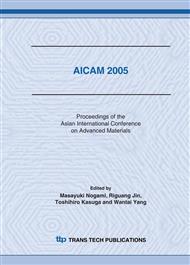p.227
p.231
p.235
p.239
p.243
p.247
p.251
p.257
p.261
PLLA/HA Electrospin Hybrid Nanofiber Scaffolds: Morphology, In Vitro Degradation and Cell Culture Potential
Abstract:
Electrospinning has recently emerged as a potential technique for fabricating biomimetic tissue engineering scaffolds. In this study, Poly (l-lactic acid) (PLLA) /Nano-hydroxyapatite (HA) hybrid nanofibers scaffolds were prepared by electrospinning. The relationship between process parameters and fiber diameter has been investigated. The fiber diameter decreased with decreasing polymer concentration and with increasing electrospinning voltage; After 6 weeks of in vitro degradation, the mass, viscosity-average molecular weight of the nanofibers scaffolds and the pH value of the degradation solution were changed, the fibers lost their surface smoothness and a regular rough topology was generated after 32d of degradation, the degradation rates of PLLA/HA hybrid nanofibers were slower than those of pure PLLA fibers; The biocompatibility of the nanofibers scaffold has also been investigated by culturing cells on the nanofibers scaffold, elementary results showed that the cells adhered and proliferated well on the PLLA/HA hybrid nanofibers scaffolds.
Info:
Periodical:
Pages:
243-246
Citation:
Online since:
February 2006
Authors:
Keywords:
Price:
Сopyright:
© 2006 Trans Tech Publications Ltd. All Rights Reserved
Share:
Citation:


